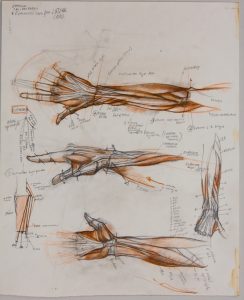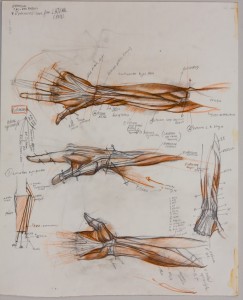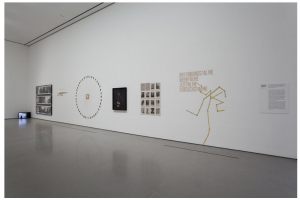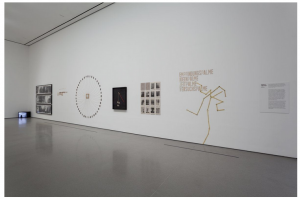Ongoing Chicanery with the Gehry Memorial
The editorial board of the New York Times is at it again, opining in high-falutin’ ways that show for the millionth time just how much this newspaper wants to set policy, rather than report it objectively.
This time the Editorial Board is commenting on the ghastly Gehry design which is supposed to honor our plain-spoken 34th president Dwight Eisenhower, but instead just serves to memorialize an aging architect’s vanity.
The august editorial board pronounced that Gehry’s “innovative and modernistic design plan…predictably raised the hackles of neo-classicists,” as if only neo-classicists would object to the appalling spectacle of a monstrous woven 80’-high metal curtain with two attached columns and two detached columns that look like smokestacks. It’s a sly piece of spin doctoring crafted to jam this dreadful design down the throats of the American people. It is a marketing sleight-of-hand to relegate criticism of these plans to the category of “raising the hackles of neo-classicists.”
After all, neo-classicists don’t matter, so no one should care what that insignificant group thinks. No worries, the New York Times will tell you who does matter.
But it’s not just benighted neo-classicists who are appalled by Gehry’s design. These ugly tapestries have been widely said to evoke concentration camps, not a great and humble leader who loved his country and his family—who surely would have wanted his family’s voices to be heard regarding his memorial.
At least in this press release Rocco Siciliano, Chairman of the Eisenhower Memorial Commission, isn’t openly sneering at the Eisenhowers. Instead, there’s a dismissive throwaway line, “Critics continue to object, including members of the Eisenhower family.”
At this point, I will repeat the disclaimer I included in my post last year, “The Problem with the Frank Gehry Memorial”: I am the wife of sculptor Sabin Howard, who was courted by Frank Gehry for the Eisenhower Memorial, told the sculpture gig was his and he would begin working on the project next week, and then suddenly dropped.
But this is the least of the ugly business surrounding this memorial project. There’s the misrepresentation in the editorial piece that the lengthy opposition to Gehry’s design is typical of the process for memorials in Washington. In fact, this is not true, and is another example of spin doctoring to achieve an objective.
Fifteen years of objections is not typical. The Vietnam memorial, for example, shows another way—a better way. An open design competition was held beginning in December, 1980. Maya Lin’s breathtakingly gorgeous Memorial Wall won.
Yes, there was controversy. The Three Soldiers sculpture was added because of the controversy, and ground was broken in March, 1982. Lin’s design, in its stunning and elegant simplicity, shocked many people. It still took less than two years to break ground.
It also required far less than the more than $42,000,000 that has already vanished into the maw of the Gehry design, according to the eisenhowermemorial.net website, with almost nothing to show for it. Is this $42,000,000 taxpayer money or privately raised money? There is so much obfuscation about the money that it’s hard to tell—and I made some phone calls to that end.
Indeed, the bigger question here concerns finances, which the New York Times editorial saw fit to overlook. How has this money been spent? Where has it all gone? Don’t the American people deserve an accounting? If it’s taxpayer money, then we have the right to demand one. If it’s privately raised money, since the memorial is a public project, We the People have a stake.
Instead of discussing the specific details of financing, including the vanished $42,000,000 and the estimated additional $140,000,000 required to build Gehry’s design, the Times editorial quotes Representative Darrell Issa as saying, “We can’t go back to square one. We have an obligation after fifteen years to get this thing going.” Note: the editorial makes careful mention of Issa’s status as a “senior Republican.” After all, approving of a Republican means the New York Times isn’t biased on this issue.
I personally think we have an obligation to create a beautiful memorial that will serve both the memory of a beloved president and the American people, something with the grandeur of the Lincoln Memorial or the Vietnam Memorial. Note that both of those monuments are about their subjects, not about their architects.
But time is an issue for the Gehry Memorial because Gehry himself is so very elderly.
If there is never going to be an open competition for the Eisenhower Memorial, and if, in fact, Gehry’s self-aggrandizing design is going to be inflicted as a fait accompli on this nation, then at least show us where the money has all gone. Don’t just sweep it under the rug. Eight figures worth of cash has disappeared. Give us a line-by-line accounting of that money.
I’m not saying that anyone absconded with the money. Nor am I suggesting that it’s lined anyone’s pockets to keep a bad plan rolling. It is, however, most interesting that in September the Gehry Memorial was reported to be on life support, and then suddenly in mid-October the plan was passed, a done deal, with the Commission refusing to address any aesthetic concerns. Huh? Was that money well-spent?
If no one else will say that the emperor has no clothes, then I will. Gehry’s design is hideous and will be an eyesore in this nation’s capitol. Refusing to address the legitimate, ongoing aesthetic concerns, and refusing to inquire into possible financial mismanagement of memorial funds, is a way of pulling the wool over the eyes of the American public, the very people who are supposed to benefit from the memorial, and who are putting up 80% of the funds for it.
I suggest that a fair and open competition would best serve the integrity of President Eisenhower’s memory, and that it is most likely to yield us a design that is both innovative and beautiful. To Representative Issa, and to everyone else, including those who connive to ignore the aesthetic concerns, I say: It is time to start over. Scrap this terminally ugly, expensive project. If that’s not possible, then create an Eisenhower sculpture, a sculpture of President Eisenhower, that will be a fitting tribute to the statesman and to the country he served with such distinction. Iron smokestacks and giant metal drapery won’t do it.

Copyright: sborisov / 123RF Stock Photo
Hear this post as a podcast at the Traci L. Slatton podcast channel
or listen here [sc_embed_player_template1 fileurl=”http://tracilslatton.com/eqongoingchicanery.mp3″]








